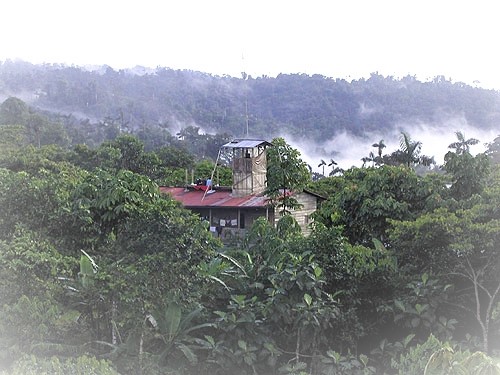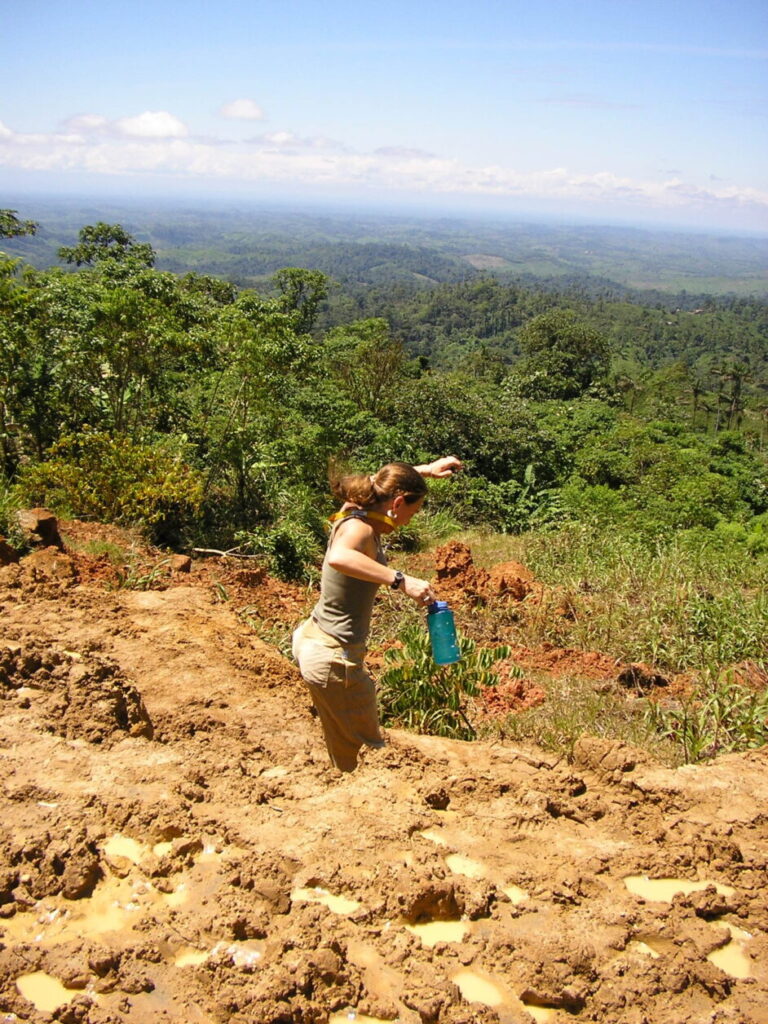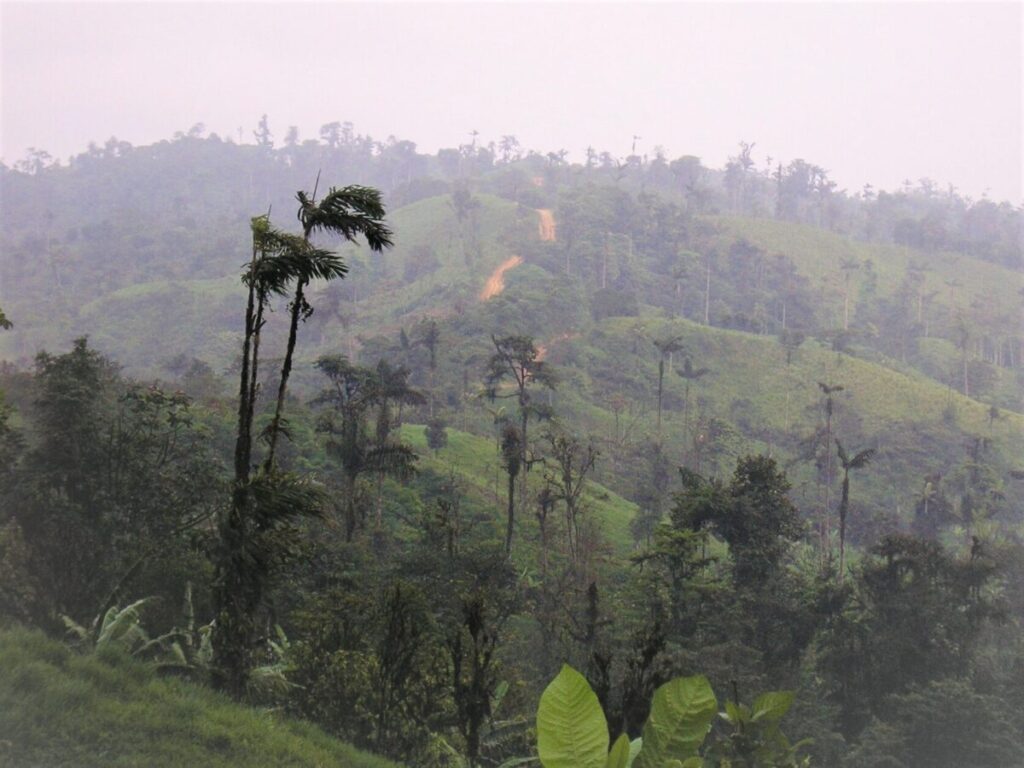A Girl’s Guide to Surviving the Parasites of South America
by Lisa Riley
Chapter 2: Botfly
Read chapter 1. here.
(Preface: As with my experience with la Nigua, I was never actually diagnosed with a botfly. My “diagnosis” was based on my symptoms as compared with other “known” (by me) 828 cases of botfly larvae in the region, which were also likely unofficially “diagnosed”. So who knows. Note: This is a story that starts off with a botfly, but ends up being about poor decision-making, as most good travel stories are. Enjoy.)
How the Botfly Works
The human botfly, Dermatobia hominis, parasitizes humans by use of other insects—primarily mosquitos. The botfly actually catches a mosquito and lays their eggs on it. Then lets it go. (Insects are so creepy and yet so cool.) Eggs either hatch while the mosquito is feeding (on us), or they are dropped onto our skin and hatch later. Either way (gross), the newly-hatched larvae make their way inside the breached skin at the point of the mosquito bite and begin feeding.
Identifying Your Botfly
What happens next, is that you end up with a slow-growing sore that looks like a really big zit or a boil. Think: cystic acne. But instead what you have is actually a live worm encapsulated in your skin. There is even a white “head” on it (actually a breathing tube, but we’ll get to that later). It is painful and sore, and hot to the touch. I mean, hot – like there is a miniature power plant underneath your skin. Did I mention it’s painful?
My Botfly
I had seen numerous botfly larvae during my time working in Ecuador. I’d even helped brainstorm how best to kill them while in the jungle and without proper medical care. There were all sorts of local remedies out there. The most common was to blow cigarette smoke onto the lesion (to relax the worm, supposedly), then squeeze it out like you’re popping a pimple. This made some sense, as the hole in the middle of the sore contained the breathing tube for the larva. Presumably, the nicotine would drug it out a bit, at least long enough for it to loosen the grip of its anal hook (you think I’m kidding).
So, when I discovered a very painful lump (with a white head and hot to the touch) on my upper thigh…okay, my lower butt cheek…I had my (then) Ecuadorian boyfriend attempt an eviction. He took long drags off one of my cigarettes (poor guy didn’t even smoke) and blew them into the breathing hole —almost passing out in the process. Then, he proceeded to squeeze the shit out of that sore. And, lots of shit did come out in the form of puss— along with lots of screams into my pillow. It felt like he was punching and stabbing me in the butt cheek at the same time.
Maybe a tiny little larva even came out. He wasn’t sure. I wasn’t sure. All I knew was that I couldn’t stand anymore. I was sweaty and breathing heavy, practically in tears, and my boyfriend looked fearful for his life. (I don’t think a woman had ever used that language with him before. Not even his mother.) Chances were, the botfly was dead (if indeed, it was a botfly). But I didn’t want to risk it. So, I took precautions – namely, a strip of duct tape over the sore to try to suffocate the little bastard if he was still in there (another popular field remedy).

Adventures with My Botfly
As it turned out, this botfly incident coincided with the last night of one of my vacations. I was volunteering in Ecuador at the time, working a schedule of 20 days on-10 days off, and this was the end of one of my 10-days-off periods. The following morning was our scheduled day to go back into the field. Specifically, we were heading to Bilsa Biological Station, a remote field station set on a 3,000-hectare reserve (la Reserva Biologica Bilsa), which is itself set within the much larger (120,000-hectare) Mache Chindul Ecological Reserve.
Bilsa is nestled in the middle of one of the few islands of Chocó-Darien tropical forest left in Ecuador, which happens to be one of the most biodiverse ecoregions in the world. Basically, that means that there are more different species there per square foot of area than anywhere else. In addition, there is a ridiculously high rate of endemism – that means there are literally thousands of species of insects, plants, and even birds, that are not known to occur anywhere else in the entire world.
In other words, it’s a pretty special place.
It’s also a pain in the ass to get to – about 13 kilometers from the nearest town. And, getting to that nearest “town” is no picnic. You have to maneuver a long bus ride (3 hours from the coast, 5 hours from Quito) to the nearest city, Quininde, after which you have to ride in the back of a truck for an hour and a half to get to the “town,” La Ye de la Laguna (the “Y” in the road by the lake). The ride in the back of the truck generally involves 10-15 other people, mostly locals, plus whatever they are taking in with them – could be chickens, 100-lb. bags of rice, sacos of rotting cacao seed, crates of beer, spools of wire, jugs of water or paint. You, get the picture.
The trip sometimes turn into an hour and a half of discomfort and instability that involves trying to keep your foot wedged under the rotting cacao and your hand wrapped around the shifty, poles set across the middle of the truck bed to keep from falling on the woman holding her baby as the driver careens around corners, splashes through mud puddles, and does his best to scare the shit out of everyone. If you are very lucky, the truck has one of those over-the-cab racks you can sit on instead, with a bar to hold onto so you don’t go plummeting to your death. But even that place of relative comfort can be hard on the old nalgas.
Our general procedure (my field crew and I) was to do some of our shopping on the last day of vacation but to acquire all of our fresh, perishable food in Quininde. With no electricity in Bilsa, and thus no refrigeration, perishable food was only good for the first week or so of our stay. After that, we pretty much subsisted on dried and canned goods, so we put off buying that stuff until the last possible moment. In the case of the botfly incident, we had a bit of a slow start that morning as I was still quite sore, and by the time we got our shopping done in Quininde and made our way by truck to La Ye de la Laguna, it was already getting dark.
La Ye is not the end of the road. As I mentioned before, it is merely the closest “town” to Bilsa. And I use that term loosely. It has a rough medical center, a school, and a couple of small businesses, along with maybe a few hundred people who live there. What La Ye really is, is the last place where the road is regularly maintained. Beyond that town, the road is cleared approximately once each year. And, when it becomes too wet to pass, it is really too wet. I helped push a pickup out that road one year, at the beginning of the wet season, because we could no longer drive it.
This cuts through Mache Chindul reserve, connecting the 30-something communities who call the reserve their home. It also passes by Bilsa Biological Station. When it can’t be driven (most of the year), people travel it the same with horses and mules, or else by foot with horses and mules carrying their stuff. People move their livestock up and down the muddy road, as well. By the end of the wet season, it is an effort in mud-drenched futility to try to walk the road if you don’t know all the secret “pathways”. You just end up sunk in a mud wallow up to your knees, crying because the mud sucked the boot off your foot and you can’t seem to get it back. But I digress.

Despite the clear lunacy of the endeavor, we generally opted to walk rather than ride the local pack horses or mules. I mean, once in a while you would be too tired to walk the 13 kilometers, but mostly you didn’t want to deal with the headstrong, non-English speaking, half-beaten pack animals. They never listened to anything you said, and would either take off running or stop to graze for an hour, depending on the whim of the moment. There was literally nothing you could do about it. In this instance, however, on the day after the botfly incident, I happened to still be in a lot of pain. To put it plainly, my ass hurt. Sitting hurt, but walking hurt worse, and slipping and sliding over mud-slick hillocks sounded worst of all.
Bad Decisions & the Botfly
My work partner (who shall remain nameless to protect her reputation) and I decided we would ride in. It was almost dark, we were both a bit hungover and a lot exhausted, and there was going to be a full moon. Furthermore, we decided to take full advantage of our luxurious perch on the stubborn animals, and get drunk on our way in. Before leaving La Ye, we purchased a gallon jug of Tampico (sort of like Sunny Delight) and a pint of Caña, a local liquor made from sugar cane; cheap and potent. We poured the Caña into the jug of Tampico and started our ride in.

The first half of our journey went okay. Well, it was a bit uncomfortable for me – due to my Botfly “injury”. I was sitting on the horse that had all of our stuff strapped to the sides of it, cowboy-style. We had fashioned a sort of cushion between the big sacos full of stuff and I was perched up on the cushion, with my legs dangling over the front as I couldn’t reach the stirrups. But, I had relegated myself to my lack of control and was enjoying the temporary numbness provided by the Caña. We gossiped and chatted while our horses meandered along, and by the time we reached the house that marked the mid-point of our journey (also the house of the horse-owner, don Amado), we were pleasantly buzzed and still enjoying ourselves.
Now, don Amado is not just a horse owner and all-around good guy — he is one of the local entrepreneurs. Don Amando makes a pretty good living renting horses and mules to tourists, volunteers, scientists, and other people working in the reserve, transporting all their food and gear (and sometimes themselves) into and out of the jungle. Ever business-minded, he also set up a store in one side of his house, run by his wife and kids, that sells water, soda, warm beer, Caña, and snacks to people passing through . There is a little courtyard to sit in, with seats and hammocks and lots of shady plants. Don Amado’s no dummy, and neither is his wife.

We were relaxing for a few minutes and grabbed another jug of Caña-spiked Tampico for the road. Then we loaded back up on our horses and off we went.
Now, it is important at this point in the story to point out that, during this particular journey, we each happened to be riding one of the 2 lead pack horses. We were also taking so long that everyone else had moved way out ahead of us, and we were lagging far behind. The moon was full, and though it was dark in the middle of the jungle, the pale-dirt road was lit up as if lined with powerful streetlamps. It was beginning to dry out, not as treacherous as it was earlier in the year, and the horses were restless. They wanted to run. We were restless; we’d been drinking. Running seemed like a fine idea! My partner said “We should run!” and I said, idiotically, “Yes!”
So we did.
Her horse took off and mine took off after it, cantering up the uneven, still-slippery, dirt/mud road by the light of the full moon, and I quickly realized why it was not such a fine idea, for me at least. Remember how I said I couldn’t reach the stirrups? Yeah. No stirrups, no control. I went bouncing along atop the running horse, and soon I was screaming for my partner to stop, but she thought I was laughing, and so she kept running.
My horse caught up with hers, and tried to take the lead going uphill, and her horse reared up quick as a snake and kicked back at my horse. She hardly even noticed the movement from her vantage atop the kicking horse; hardly even felt it. But I did. A sharp pain lanced through the front of my leg, about mid-way up my shin bone, and fired up my leg and into my groin like a bullet traveling through my femoral artery. I almost fell off my horse. I was really screaming then, and finally, she realized I wasn’t laughing. She stopped her horse, so mine stopped too, and she shined her headlamp on my leg as I wailed and blubbered. There was a big bloody hole in my pants, right in the middle of my left shin.

There is more to this story, of course: A brutal night spent at don Amado’s house, with nothing but baby aspirin to dull the mind-numbing pain; a plant that might have saved my leg from infection; a decision to continue into the jungle rather than seek medical attention; a full week of agony and trying to avoid maggots; my eventual eviction by the director of the preserve who caught me limping around the field station on my one crutch and asked to see my then-getting-infected wound; my even more painful horseback ride back out of the field station; a stay in la Ye de la Laguna medical center; and a month-long recovery in Quito. All resulted in a really ugly scar. Lots of other stories, I guess, for other times. This one ends here, because well, this story is about a botfly.
The Demise of My Botfly
‘What happened to the botfly, then?’ you might ask. Who knows? Certainly not me. I forgot all about the botfly in the midst of my crippling pain and agony during the next few weeks, and by the time I remembered, it was long gone. Perhaps my boyfriend did manage to squeeze the little bugger out. Or perhaps the duct tape suffocated it and it died in my subcutaneous tissue, to be evicted (grossly) by my body at some point. I have no idea. I had bigger fish to fry.

Tips for Preventing, Identifying and Treating human Botflies
Following are some tips for identifying and dealing with human botflies (my best guess as to the actual identification of this parasite):
Identification:
- A botfly adult is a hairy fly that is yellow with black stripes and resembles a large bee.
- The “sore” referred to in my account (above) is called Myiasis, which is just a fancy term for an infection caused by larva (maggots) living in your skin (gross). According to the CDC, once they penetrate the host’s tissue, newly-emerged botfly larvae “feed in a subdermal cavity for 5-10 weeks, breathing through a hole in the host’s skin. Mature larvae drop to the ground and pupate in the environment.”
- com says “The larva, because of its spines, can pose an extremely painful subepidermal condition.” No kidding. This presents, as stated before, as an unusually large, hot boil, generally with an aperture (hole) in the center, and sometimes you can feel the larva move around inside (really creepy).
- Botfly larvae may emit some sort of antibiotic into the epidermal tissue, to prevent their home from becoming infected and forcing them out. Though a sore may appear red and hard and painful, it will generally not become infected unless the larva dies in situ.
- Human botflies are fairly common in tropical regions throughout the Americas. So, if you’ve been traveling in Central or South America, and there were mosquitos, then you had the opportunity to be exposed to botfly eggs. If you get a sore that looks like the one described above, you’d better go to your local CDC. Or at least buy some duct tape.
Treatment:
- As stated, there are many folk cures for botflies, many of which are quite effective. The idea is to weaken the larva so that it is easier to remove it, and so that you don’t end up with a decomposing insect buried in your skin to cause infection. Here are a few:
- Duct tape. Place to completely cover sore, leave on for at least 24 hours. I originally heard scotch tape, but that doesn’t work at all – first, it doesn’t stick to sweaty tropical-weather skin, and second, the botfly larva can push its stupid little breathing tube right through that flimsy plastic. Duct tape. It suffocates the worm. Leave it on long enough, the worm will die. Note: be sure to extract the larva/corpse to complete treatment.
- Smear a big wad over the sore and seal it in somehow. Some recommend filling a bottlecap with Vaseline and strapping that over the sore with medical tape. Again, leave on for at least 24 hours.
- Raw meat. You heard me. Strap a piece over the sore and wait for the larva to crawl out of his own accord. The grass is always greener, you know…
- Cigarettes and a lot of squeezing, as described above. Another method has you blow the smoke into a bottle, then hold the bottle opening over the sore, thus immersing the breathing tube in pure smoke. A venom extractor may be used in lieu of all the squeezing.
- Though most people would probably be too grossed out to try it, there is nothing (in most instances) to stop you from leaving the botfly alone to complete its metamorphosis. That is, let it hatch out of your skin. (I have read and heard about a couple of entomologists doing this. One from a facial myiasis in front of a bank teller. Hilarious.)
- If you do exhibit signs of secondary infection, see a doctor. They can prescribe appropriate antibiotics. If the larva is still alive, they can remove it surgically or dose you with the antiparasitic avermectin which will cause the larva to spontaneously emerge.
Prevention:
- Botfly eggs are deposited onto mosquitos and introduced to humans through mosquito bites. Wear repellant and long sleeves to avoid being bitten.
- Stay indoors after dusk and before dawn to avoid the most active periods for mosquitos.
- Avoid areas with dense concentrations of mosquitos and botfly adults (areas close to streams and standing fresh water).
READ MORE
A GIRL’S GUIDE TO SURVIVING THE PARASITES OF SOUTH AMERICA: LA NIGUA
SELF-EXPLORATION: A GUIDE TO ESSENTIAL OILS & MEDITATION
MORNING MOTIVATION: THE BEST WAYS TO START YOUR DAY






